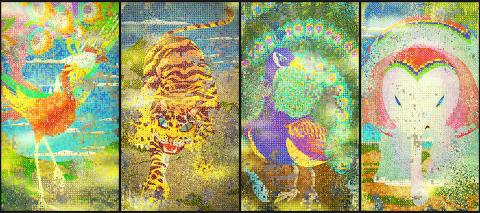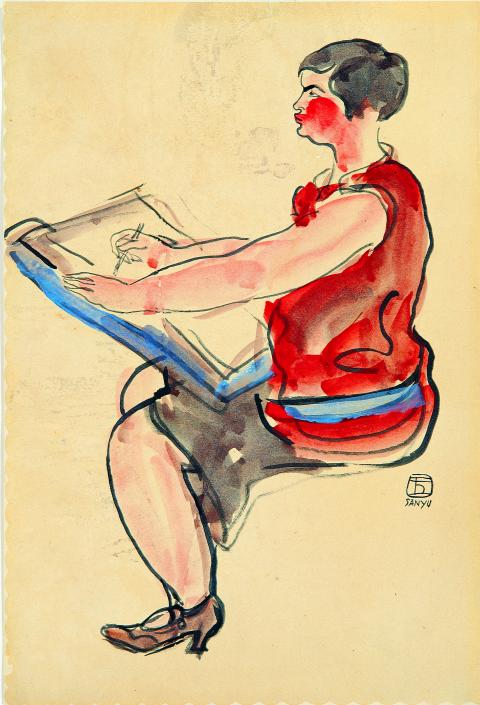Art Taipei (台北藝博會) felt like a minimally designed, intimate dinner party with a moderate market adrenaline. Hosted by Taipei’s World Trade Center (台北世貿中心) from Thursday to Sunday last week, the gray and white event was subtly decorated with occasional LED gateways and modern chandeliers that lent it a touch of noble prestige in the otherwise gridded modules of white-cubed spaces. At the main entrance, Art Taipei’s academically sounding theme The Rise in Private Art Museums was spelled in big letters, promising that this year’s program was set up to be much more than a trade show experience. Along the aisles, familiar dealers and collectors casually chitchatted with each other, catching up on old friendships and art world news.
Considerably smaller in size than previous years, the 24th edition of Art Taipei hosted 123 galleries from 15 Asian countries, including China, Taiwan, Hong Kong, Korea, Japan and Southeast Asia. Organized by Taiwan Art Gallery Association (社團法人中華民國畫廊協會), Taiwan External Trade Development Council (中華民國對外貿易發展協會), and the Ministry of Culture (文化部), Art Taipei is the longest running art fair in Asia and has established itself as a senior platform for artistic and commercial exchange within the Asian region. While Hong Kong has quickly risen as an epicenter for art dealing within the last decade, Art Taipei continues to vie for critical position as a center for international exchange. With the proliferation of art fairs across Asia, the fair this year seemed to show a strategic shift in its approach to maintaining a stake in the regional network.
The fair’s title set up a contemplative mood for discussion about collection building and institutional development. In addition to being a leading force in the art market, according to Minister of Culture Cheng Li-Chun (鄭麗君), Art Taipei “is an exchange platform for culture and thought, and an embodiment of contemporary art trends and the spirit of the times.” By placing emphasis on the cultivation of arts, the fair shows potential for a refreshing blend between art appreciation and business talk.

Photo courtesy of Liang Gallery
With a total offering of 3,000 works this year, Art Taipei reportedly hit NT$5 million in total sales by the second day. Representing works by Yoyoi Kusama and Shiro Tsujimura, Nukaga Gallery achieved a collective sales of almost NT$2 million. Wu Hsueh Jang’s (吳學讓) ink paintings at Mingshan Art (名山畫廊) were 80 percent sold by the first day of the fair. Other pieces that attracted collector’s interest include Tang Jie’s (湯傑) Stone Story (石雨) and Geng Jie-Sheng’s (耿傑生) A Very Sociable Kevin (合群的凱文) at Daxiang Art Center (大象藝術中心).
CONSERVATIVE FAIR
Overall, the fair showcased a largely conservative yet good-quality selection of modern and contemporary artworks. Many galleries featured well-curated booths of single or multiple artists that provided visitors with more than a salesroom experience. Liang Gallery (尊彩藝術中心) devoted a good portion of its booth to watercolors on paper by prominent Taiwanese modern painter Chen Cheng-Po (陳澄波). Dating from the early 1930s, the sketches are valuable traces from the painter’s critical Shanghai period during which the Chinese literati tradition heavily influenced his painting style.

Photo courtesy of Liang Gallery
Eslite Gallery’s (誠品畫廊) solo presentation of post-war Taiwanese master painter Tommy Chen (陳道明) offered substantial insight into the artist’s practice of colorful cosmic abstractions. Asia Art Center (亞洲藝術中心) chose a Pan-Asian approach, bringing together a selection of paintings, including works by Pan Hsin-hua (潘信華) and Chu Wei-bor (朱為白), Singapore’s Cheong Soo Pieng (鍾泗濱) and China’s San Yu (常玉) and Zhao Wou-ki (趙無極). The piece by Zhao Wou-ki, in particular, is a remarkable 1930’s black painting with an etched in landscape of mountains and cathedrals.
Alisan Fine Arts (藝倡畫廊) from Hong Kong also joined the fair this year after over two decades of hiatus. Featuring a selection of iconic works including paintings by Walasse Ting (丁雄泉) and Nobel Laureate Gao Xingjian (高行健), the gallery hoped to reconnect with Taiwanese collectors and catch up with old friends, said one of its gallery spokespersons.
Despite Art Taipei’s modern art emphasis, many galleries also showed internationally distinguished contemporary artists. Yoshiaki Inoue Gallery presented an intriguing group of miniature, wood-carved dolls by Hiroto Kitagawa that explored themes of role-play and character building.
Ikkan Art Gallery from Singapore brought a collection of monitor-based works by Japanese digital collective teamLab. Fleeting Flowers is a four panel, software animated series that featured pixelated animals that, according to legend, accompanied the Buddha at the end of his life. The animal images are assemblages of blooming flowers that repeated their cycle of growth and decay, causing the animals to emerge and disintegrate by the flower’s state of existence. According to dealer Ikkan Sanada, the artists had gone to substantial effort to ensure the greatest permanence of its digital artwork, by providing a renewable 10-year guarantee so that the work would be periodically treated with necessary upgrades that accommodate future operating systems and other software running technologies.
This year’s Art Taipei, though mostly pleasant and non-risky, hit a sound balance of culture and commerce. This may be a good strategy for Taiwan’s international positioning, which compared to the higher pressure markets of Hong Kong and Shanghai, seems to be prime setting for a more conservative market approach, museum-oriented cultural discourses and a more lyrical art atmosphere.

April 14 to April 20 In March 1947, Sising Katadrepan urged the government to drop the “high mountain people” (高山族) designation for Indigenous Taiwanese and refer to them as “Taiwan people” (台灣族). He considered the term derogatory, arguing that it made them sound like animals. The Taiwan Provincial Government agreed to stop using the term, stating that Indigenous Taiwanese suffered all sorts of discrimination and oppression under the Japanese and were forced to live in the mountains as outsiders to society. Now, under the new regime, they would be seen as equals, thus they should be henceforth

Last week, the the National Immigration Agency (NIA) told the legislature that more than 10,000 naturalized Taiwanese citizens from the People’s Republic of China (PRC) risked having their citizenship revoked if they failed to provide proof that they had renounced their Chinese household registration within the next three months. Renunciation is required under the Act Governing Relations Between the People of the Taiwan Area and the Mainland Area (臺灣地區與大陸地區人民關係條例), as amended in 2004, though it was only a legal requirement after 2000. Prior to that, it had been only an administrative requirement since the Nationality Act (國籍法) was established in

With over 80 works on display, this is Louise Bourgeois’ first solo show in Taiwan. Visitors are invited to traverse her world of love and hate, vengeance and acceptance, trauma and reconciliation. Dominating the entrance, the nine-foot-tall Crouching Spider (2003) greets visitors. The creature looms behind the glass facade, symbolic protector and gatekeeper to the intimate journey ahead. Bourgeois, best known for her giant spider sculptures, is one of the most influential artist of the twentieth century. Blending vulnerability and defiance through themes of sexuality, trauma and identity, her work reshaped the landscape of contemporary art with fearless honesty. “People are influenced by

The remains of this Japanese-era trail designed to protect the camphor industry make for a scenic day-hike, a fascinating overnight hike or a challenging multi-day adventure Maolin District (茂林) in Kaohsiung is well known for beautiful roadside scenery, waterfalls, the annual butterfly migration and indigenous culture. A lesser known but worthwhile destination here lies along the very top of the valley: the Liugui Security Path (六龜警備道). This relic of the Japanese era once isolated the Maolin valley from the outside world but now serves to draw tourists in. The path originally ran for about 50km, but not all of this trail is still easily walkable. The nicest section for a simple day hike is the heavily trafficked southern section above Maolin and Wanshan (萬山) villages. Remains of